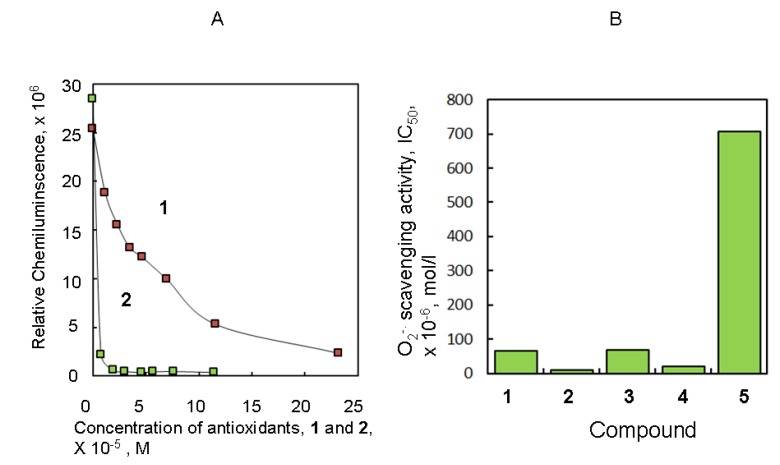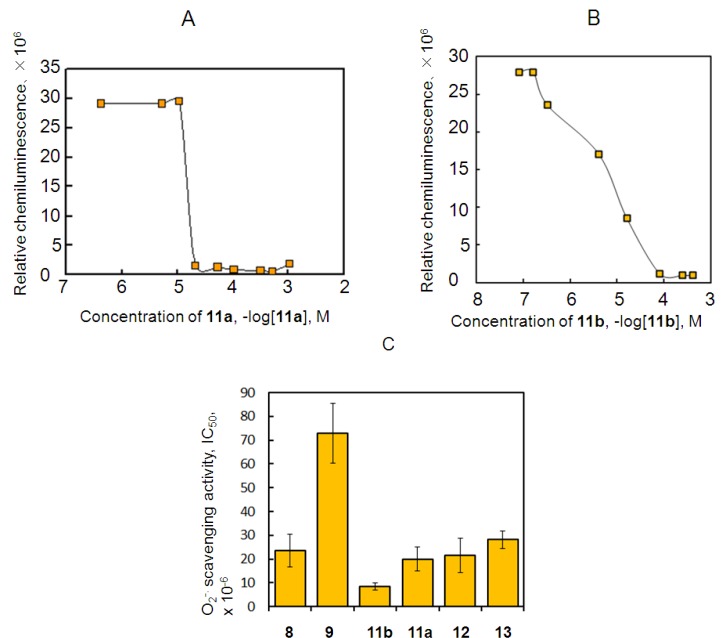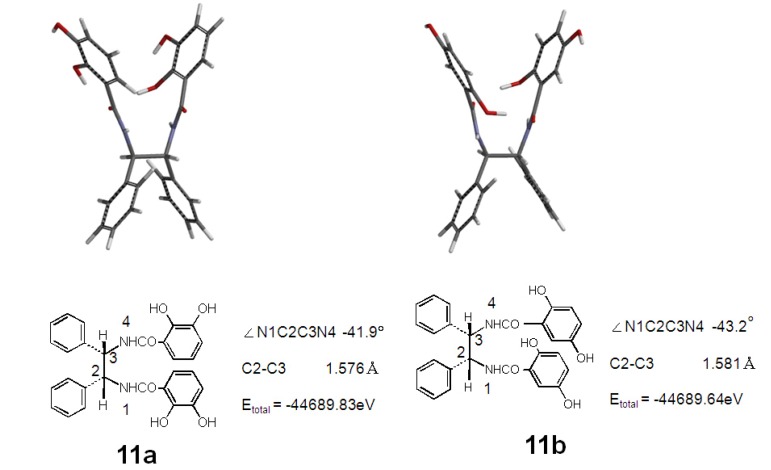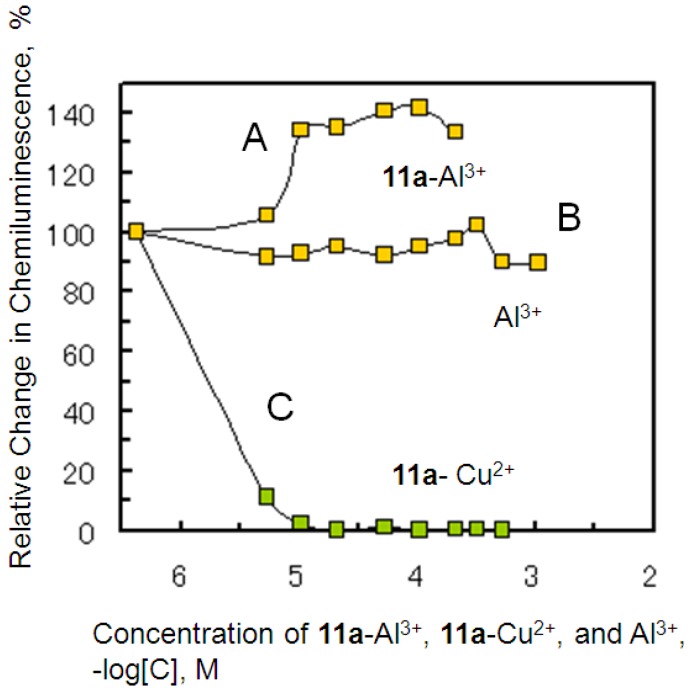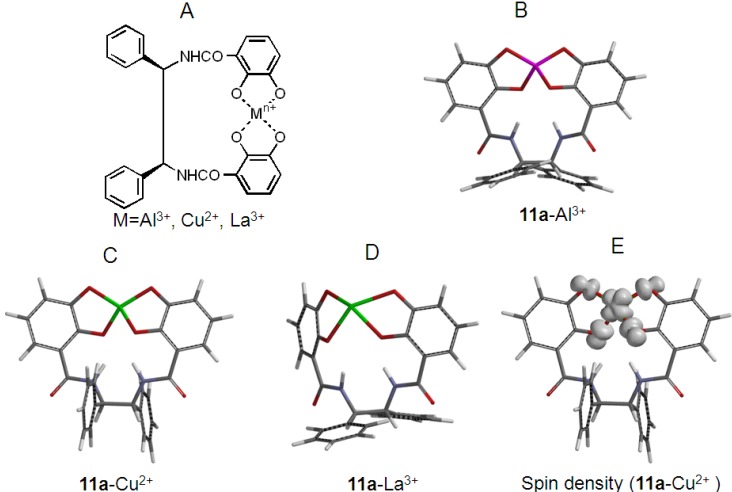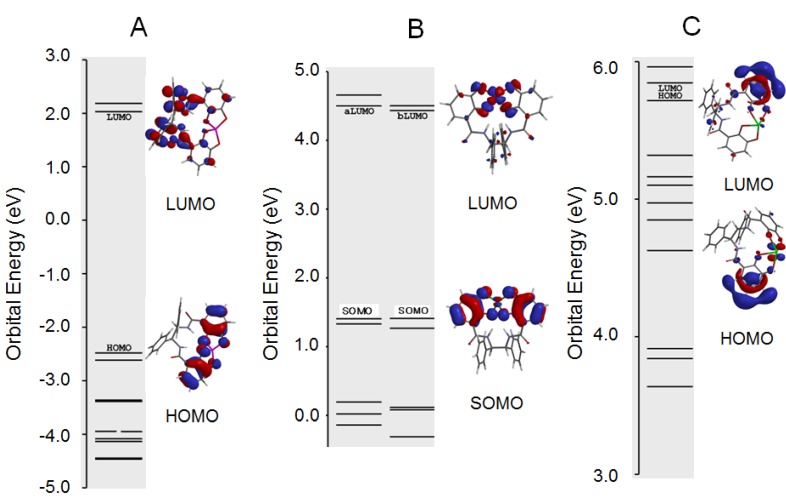Abstract
Novel antioxidants have been synthesized and characterized by their chemical properties as antioxidants with high superoxide scavenging activity. (2R,3R)-diphenylethylenediamine is a spacer in antioxidants, and we synthesized targets 11a and 11b by conjugation with o-hydroquinone and p-hydroquinone at the two N-termini, respectively. Superoxide scavenging activities of the plant flavonoid-like 11a and 11b were compared with those of known antioxidants, and shown to increase in the following order: curcumin << ascorbic acid < Trolox < (+)-epicatechin < 11a < quercetin ° 11b. Compound 11a also formed a solvated 11a–metal complex with metal ions. The 11a–Cu2+ complex was shown to have higher superoxide scavenging activity than that of 11a, 11b, Cu2+, and the 11a–Al3+ and 11a–La3+ complexes, whereas the 11a–Al3+ complex increased rather than decreased superoxide levels. The 11a–Al3+ complex did not abstract one electron from the SOMO of O2−. since the HOMO and LUMO phases of Al3+ do not exist in the center of the 11a–Al3+ complex. However, the SOMO of the 11a–Cu2+ complex distributed in the center of Cu2+ may abstract one electron from the SOMO of O2−.. These results suggest that 11a and 11b are powerful antioxidants.
Keywords: superoxide, catechol, p-hydroquinone, antioxidants, density functional theory, aluminum, copper, lanthanum, solvated metal complexes
1. Introduction
Superoxide (O2−.) and the hydroxyl radical (OH.) are produced by the reduction of O2 and have doublet spin multiplicity. These radicals are highly reactive and cause oxidative damage by the abstraction of an electron or H radical from biomolecules, especially proteins, lipids, and DNA. The excessive production of reactive oxygen species (ROS) in the body may be the most dangerous factor of many diseases such as inflammation, diabetes, cancer, aging, and neurodegenerative diseases including Parkinson’s and Alzheimer’s diseases [1,2]. Therefore, in recent years, many studies have investigated how to protect against ROS-induced oxidative damage using natural antioxidants such as vitamin E, vitamin C, and plant products such as flavonoids [3,4,5]. Russo et al. compared radical scavenging activities using a correlation between O-H bond dissociation enthalpy (BDE) and the ionization potential (Ip) for the mechanism of the free radical oxidation of flavonoids [6,7]. Reactions between the antioxidants and metal complexes of flavonoids and OH or OOH radicals have also been investigated using computational kinetics methods [8]. Moreover, the metal ion effect for the radical scavenging of catechin has been investigated by kinetics analyses using the stopped flow method [9]. However, the design and production of more effective synthesized antioxidants and antioxidative metal complexes with their related products are less challenging than those of natural antioxidants.
The electronic states and estimation of the scavenging activities of antioxidants [10,11], using absolute hardness (η) and electronegativity (χ) based on the chemical hardness theory [12,13,14], are very important to consider for the design process of antioxidants. We paid particular attention to the catechol ring substituted at C2 of the B ring in flavonoids because our previous studies have shown that the catechol ring produces chemically soft flavonoids. Conjugation of the catechol ring increased the electron donation, η, and χ of flavonoids [10]. p-Hydroquinone is a likely catechol ring with a similar radical scavenging activity to catechol. In this study, the radical scavenging activities of natural products and the novel antioxidants, 11a and 11b, were estimated by a reaction with O2−., which was yielded from the hypoxanthine (HPX)-xanthine oxidase (XOD) system. We showed that the O2−. scavenging activity of 11a and 11b was higher than that of ascorbic acid, (+)-epicatechin, curcumin, Trolox, catechol, and p-hydroquinone.
We previously reported the synthesis and chemical properties of the solved complex of bis(amino acid)catechol derivatives with lanthanoid (Ln3+) ions [11,15,16]. We paid attention to the fact that Al3+ and Cu2+/+ ions, besides amyloid β protein misfolding and self-assembly, are causative compounds of Alzheimer’s disease [17,18]. To investigate the influence of metal ions and metal complexes on the production and elimination of ROS, we measured O2−. scavenging ability through chelation since 11a could form metal complexes with Al3+ and Cu2+ ions. It has been suggested as the active site since the 11a–Al3+ and 11a–La3+ complexes have no or less effective O2−. scavenging activity. However, we found that low concentrations of the Al3+ ion slightly accelerated the formation of O2−. by binding with 11a.
To anticipate the strength of potency for the O2−. scavenging activities of Al3+, Cu2+, and La3+, we discussed the electronic states of Al3+, Cu2+, La3+, 11a–Al, 11a–Cu, and 11a–La complexes using the chemical hardness theory described above. The absolute hardness of Cu2+ is smaller than that of the Al3+ and La3+ ions since the coordinates r(χ, η) as the electronic structures of Al3+, Cu2+, and La3+ ions have been shown to be r(70.48, 37.96), r(25.55, 4.7), and r(15.23, 14.43), respectively, in a ground state [10,11]. A singly occupied molecular orbital (SOMO) of the d orbital of 11a–Cu2+ is widely distributed in the center of the metal ion. The 11a–Cu2+ complex easily abstracted an electron from O2−.; therefore, we demonstrated that 11a, 11b, 12, 13 and the 11a–Cu2+ complex are useful antioxidants.
2. Results and Discussion
2.1. Antioxidant Activity of Several Natural Producuts
O2−. scavenging activity was determined from the half maximal inhibitory concentration (IC50) by changes in the chemiluminescence (CL) response by the reaction of 2-methyl-6-p-methoxyphenyl ethynylimidazopyrazynone (MPEC) with the O2−. produced from the HPX-XOD system [19]. The IC50 represents the 50% concentration point of the dose-response curve of CL responses with various concentrations of antioxidants. Figure 1A shows the dose-response curve for O2−. scavenging measured at 7–8 points of a concentration range between 0.0 and 10−4 M (mol/L) of Trolox (1) and quercetin (2). Trolox is a well-known antioxidant model of dl-α-tocopherol (vitamin E) [20]. In this experiment, relative CL intensity was about 20–30 × 106 relative chemiluminescence units (RLU). The O2−. scavenging activities of 1 and 2 were 64.7 and 8.8 µM. The activities of L-ascorbic acid (3), curcumin (5), and (+)-epicatechin (4) were 68.8, 708, and 21.1 µM, respectively, from the results obtained using the same experimental method. These results are summarized in Figure 1B. Antioxidative activities were shown to increase in the following order: 5 < 3 < 1 < 4 < 2 (Figure 1).
Figure 1.
Dose–response curve of Trolox (1) and quercetin (2) on O2−. scavenging inhibition (A) and the IC50 values of several antioxidants (B). All bars were expressed as the mean.
One of the reasons why curcumin has lower O2−. scavenging activity than epicatechin is because the catecholic hydroxyl of curcumin protects the CH3 group. In the compounds tested in this study, the activity of quercetin was the most potent. The reason for this was the activity of the catechol ring. The catechol ring naturally binds at C2 in flavonoids such as quercetin, cyanidine, and rutin. Although flavonoids are expected to be natural products that provide powerful radical-scavenging activity, natural flavonoids in which the p-hydroquinone ring, a well-known regioisomer of catechol, binds to the flavonoid ring are almost unknown. The catechol and p-hydroquinone rings are useful in the development of new potent antioxidants.
2.2. Synthesis and Stable Conformation of 11a and 11b
Interestingly, quercetin and epicatechin substituting catechol to the B ring of flavone and flavanone increased O2−. scavenging activity and we designed targets 11a and 11b conjugated with two 2,3-bis(benzyloxy)benzoic acid (6) and 2,5-bis(benzyloxy)benzoic acid (7) units at the N-terminus of the (1R,2R)-(−)-1, 2-diphenylethylenediamine spacer, respectively, as shown in Scheme 1.
Scheme 1.
Synthesis of the new antioxidants 11a and 11b.
In particular, 2,5-bis(benzyloxy)benzoic acid was comparable to p-hydroquinone (8). Compound 11a, a derivative of catechol (9), was expected in the formation of a metal complex with metal ions [20,21]. Yields of 11a and 11b were lower than those of 12 and 13 due to the steric inhibition of 1,2-diphenyl groups. The crude compounds 10a and 10b were purified using column chromatography over neutral silica gel, respectively, and were recrystallized from methanol. After the purification of 10a and 10b, the benzyloxy protecting groups were removed with H2 and 5% Pd-C in methanol to yield the targets 11a (50%) and 11b (55%), respectively. Here, for example, compound 11a was purified by preparative thin layer chromatography (PTLC) using a silica gel plate with chloroform/MeOH (20:1) as mobile phase. Compounds 12 and 13 were synthesized following the same method as for 11a and 11b [10,11,12]. The compounds 11a, 11b, 12, and 13 provided satisfactory analysis by 1H-NMR, 13C-NMR, 13C-1H COSY NMR, and FAB-MS. The tyrosine (Y) α protons of 12 and 13 observed at δ 4.70 and 4.74 are coupled with an amido proton at δ 8.49 and 8.46, respectively, and the observed 3Jα,NH values are 7.1–7.8 Hz. The values indicate that 12 and 13 provide a folded β-sheet like conformation [21]. Moreover, a very broad amido proton observed at δ 9.0 may be consistent with an intramolecular hydrogen-bonded structure in double-strands of 13. On the other hand, 11a and 11b are assumed to have twist conformations since the half width values of J3H,NH of their amido protons were <3 Hz.
Compounds 11a and 11b had two catechol or p-hydroquinone rings in one molecule, respectively. When the O2−. scavenging activities of 11a and 11b were compared with those of the catechol and p-hydroquinone rings, the potency of their activities was different. Compounds 11a and 11b had powerful antioxidant activity similar to quercetin and (+)-epicatechin. Hence, we estimated the conformation of 11a and 11b using a computational method by density functional theory (DFT). The most stable conformations of 11a and 11b were computed using conformation analysis with the MMFF method. Details of the conformation and electronic state were obtained after geometry optimization using B3LYP with a 6-31G(d) basis set and the B3LYP/6-31G(d) computed results are shown in Figure 3. The most stable structures of 11a and 11b in the gas phase are also shown in Figure 2. Total electron energy (E) was more stable in compound 11a (−44689.83 eV) than in 11b (−44689.64 eV). The two catechol rings of 11a faced each other. From this conformation, it is suggested that the four hydroxyl groups of 11a can easily form the metal chelator (Figure 2).
Figure 3.
Dose–response curve of the synthesized antioxidants 11a (A) and 11b (B) on O2−. scavenging activity and the IC50 values of several antioxidants (C).
Incubation in 10 mM phosphate buffer (pH 7.5) for 2 min at 25 °C; Responses were expressed as chemiluminescence for the concentration (−log[C], M) of antioxidants 11a (A) and 11b (B); All bars were expressed as the mean ± S.D. (C) 8: p-Hydroquinone, 9: catechol.
Figure 2.
Most stable conformations after geometry optimization of 11a and 11b.
At B3LYP/6-31G(d) level; ∠N1C2C3N4 is the dihedral angle (°), C2-C3 is bond length (Å), and Etotal is total energy (eV).
2.3. Antioxidant Activity of 11a and 11b
Figure 3A shows the dose–responses curve of the CL responses obtained by the reaction of 11a and 11b with O2−.. Antioxidant activity was measured by the method described above. The results of IC50 (mean ± SD) are summarized in Figure 3B. O2−. scavenging activity was stronger in compound 11b than in 11a. The IC50 value of 11b was 8.5 (±1.5) µM and has higher O2−. scavenging activity than 11a (20.0 ± 5.0 µM), and inhibitory activity was higher in compounds 11a and 11b than in catechol and 8 alone. In particular, the IC50 of 11b conjugated 7 was about 1/2.5 times that of 11a. O2−. scavenging activity was also about four times higher by 11a than with 9 alone. On the other hand, the inhibitory activities of 12 and 13 were equal to or less than that of 7 (Figure 3C). They exhibited no effective O2−. scavenging activity relative to 11a and 11b. However, compounds 12 and 13 had powerful antioxidant activities compared to 9 alone.
O2−. scavenging activity was stronger in compounds 11a and 11b than in the natural compounds 1, 3, 4, and 5. The IC50 value of 11b was almost equal to that of quercetin 5. What are the chemical requirements that increase O2−. scavenging activity? Differences in the spacers between 12, 13 and 11a, b affect inhibitory activity. In our previous study, we confirmed the relationship between the chemical hardness and antioxidant activity of antioxidants [3,5]. The chemical hardness concept can be applied to a comparison with the O2−. scavenging power of antioxidants. By an MO calculation using B3LYP/6-31G(d), 11a (χ = 3.565) and 11b (χ = 3.480) had low absolute hardness and absolute electronegativity. Electron donation was higher in compounds 11a and 11b, with the χ values of 11a and 11b being smaller than the χ values of 2 (χ = 3.635), 3 (χ = 3.765), 4 (χ = 2.720), and 5 (χ = 3.825). Regarding the values for hardness, 11a (η = 2.215) and 11b (η = 2.340) were smaller than 1 (η = 2.650), 3 (η = 2.785), and 4 (η = 2.869), except for 2 (η = 1.835) and 5 (η = 1.836). The χ value of 11b was smaller than that of 11a. Although compounds 2 and 5 have a high driving force, their χ values were larger than those of 11a and 11b. These findings indicate that electron rich 11b is more easily oxidized when scavenging O2−. than 1, 2, 3, 4, 5, and 11a.
2.4. Antioxidant Activity of the Metal Complexes 11a–Mn+
Compound 11a forms 1:1 ratio solvated metal complexes with metal ions. To measure the O2−. scavenging activity of the metal complexes 11a–Mn+, the molar ratio of 11a to metal ions has to be 1:1 at any concentration. Therefore, we prepared the solvated 11a–Mn+ complexes of 11a with the metal ions, Al3+, Cu2+, and La3+ ions, at several concentrations. Dose–chemical luminescence curves were obtained from the scavenging reaction of the 11a–Mn+ complexes under a constant concentration of O2−., as shown in Figure 4. Although a decrease in CL was not clearly observed with the Al3+ (curve B in Figure 4), La3+ (data not shown) ions, and 11a–Al3+ (curve A in Figure 4) with O2−., a decrease in CL was seen in the scavenging reaction of the Cu2+ (data not shown) ion and 11a–Cu2+ with O2−. (curve C in Figure 4). From these results, it was shown that O2−. scavenging activity increased in the following order: 11a–Al3+ < 11a–La3+ << 11a–Cu2+ complexes, which indicates that Al3+, Cu2+, and La3+ ions were coordinated to the hydroxides of catechol rings since 11a provides strong O2−. scavenging activity, as shown in Figure 3. The complexes 11a–Al3+ and 11a–La3+ also had lower O2−. scavenging activity. The sites of the scavenging reaction of 11a were shown to be the hydroxides of the catechol rings. However, the 11a–Cu2+ complex showed scavenging activity in spite of the coordination of 11a with Cu2+ and the activity was higher than Cu2+ only at pH 7.4. In addition, we focused on the Al3+ ion, which has been implicated in Alzheimer’s disease through the process of amyloid β protein (Aβ) aggregation and oxidative free radicals [22]. The results shown in Figure 4A show that the Al3+ ion slightly accelerated the formation of O2−. by interactions with 11a. Al3+–11a complexes may have acted as a O2−. generator.
Figure 4.
Dose–response curve of Al3+, 11a–Al3+ and 11a–Cu2+ complexes on O2−. scavenging activity.
11a and the Al3+ and Cu2+ ions were mixed at a molar ratio of 1:1; The values of the y-axis represent the relative changes in chemiluminescence as % inhibition.
We prepared the solvated molecule complexes, 11a–Al3+, 11a–Cu2+, and 11a–La3+, with a molar ratio of 1:1 (= [Mn+]:[[11a]) according to the method of our previous study based on UV/Vis spectrophotometry [15,16]. Structures were obtained after geometry optimization using the B3LYP method at a molar ratio of 1:1 of Mn+ and 11a; the 6-31G(d) basis set was used for C, H, N, Al3+, and Cu2+, and the LANL2DZ basis set was used for optimization of the La3+ ion. Geometry optimized structures are shown in Figure 5. The atomic radii of Al3+ and Cu2+ ions were almost equal at 1.18 and 1.17 Å. Lanthanum (La) was 1.69 Å. These atomic radii were suitable to form the chelators of 11a with Al3+, Cu2+, and La3+ ions.
Figure 5.
Most stable conformation of the 11a–metal ion complexes after geometry optimization.
The chemical structure of the 11a–metal ion complexes (A). Metal (Mn+) = Al3+, Cu2+, and La3+ ions; Most stable conformation of the 11a–Mn+ complexes (B, C, and D): (i) M = Al3+; (ii) M = Cu2+; (iii) M = La3+; Spin density map of the 11a–Cu2+ complex (E). At the B3LYP/6-31G(d) level.
Why the 11a–Al3+ complex did not have O2−. scavenging activity was considered using molecular orbitals. Lebedev et al. reported that excess Ca2+ increased the rate of catechol oxidation with O2 [23]. However, Al3+ alone did not increase O2−. levels in our study (Figure 4). Asano demonstrated that porphyrin in the porphyrin–FeIII complex was difficult to exchange to porphyrin–Al3+ by the coordination with Al3+ [24,25]. In the HPX-XOD system, therefore, it is hard accepted that less O2−. scavenging activity in the presence of Al3+ produced by Al–XOD, formed by the reaction of Al3+ with Fe–XOD. O2−. produced by the HPX-XOD system is expected to interact with Al3+ in the center of the 11a–Al3+ complex. To understand the mechanism by which Al3+ in the 11a–Al3+ complex inhibits the O2−. scavenging reaction, we theoretically analyzed an electronic energy diagram and molecular orbital of the geometry optimized 11a–Al3+ complex. The calculated bond lengths of O–Al3+, O–Cu2+ and O–La3+ in the geometry optimized 11a–Al3+, 11a–Cu2+, and 11a–La3+ complexes were 1.806, 2.332 and 2.349 Å, respectively, as displayed in Figure 5. O2−. acted as an oxidant in the scavenging reaction with the 11a–Al3+, 11a–Cu2+, and 11a–La3+ complexes, respectively (Figure 6).
Figure 6.
Orbital energy level and the HOMO, SOMO, and LUMO phases of the optimized 11a–Metal complexes.
Orbital energy (eV), εhomo, εlumo, or εsomo of 11a–Al3+ (A), 11a–Cu2+ (B), and 11a–La3+ (C); At the B3LYP/6-31G(d) level for 11a–Al3+ (εhomo= −2.48 and εlumo = 2.03) and UB3LYP/6-31G(d) level for 11a–Cu2+ (εsomo = 1.41 and εlumo = 4.50). At the B3LYP/lanL2DZ level for 11a–La3+ (εhomo = 5.78 and εlumo = 5.85).
In the scavenging reaction, O2−. attacked the HOMO or SOMO of the metal-based MO in the 11a–Mn+ complexes. The SOMO distribution of Cu2+ ions in the 11a–Cu2+ complex was more widely distributed than that of the Al3+ and La3+ ions in the less active 11a–Al3+ and 11a–La3+ complexes, as shown in Figure 7. Moreover, the SOMO energy (εsomo= +1.41 eV) of the 11a–Cu2+ complex was significantly higher than that of the 11a–Al3+ (εhomo= −2.48 eV) and 11a–La3+ (εhomo= +5.72 eV) complexes. These results indicate the 11a–Cu2+ complex was easily reduced to 11a–Cu+. It is clear from this reason, therefore, that the value for the absolute hardness of Cu2+ was smaller than that for the Al3+ and La3+ ions since the coordinates r(χ, η) for the electronic structures of Al3+, Cu2+, and La3+ ions were r(70.48, 37.96), r(25.55, 4.7), and r(15.23, 14.43), respectively, in the ground state [15,16]. The SOMO of the d orbital of the Cu2+ ion in the 11a–Cu2+ complex was more widely distributed in the center of the metal ion than that of the Al3+ and La3+ ions. The spin density of SOMO was presented in Figure 5E, where it was computed with B3LYP with 6-31G(d).
3. Experimental
3.1. Materials and Methods
Pyrocatechol (2,3-dihydroxybenzoic acid), p-hydroquinone (2,5-dihydroxybenzoic acid), (1R,2R)-(+)-diphenylethylenediamine, 2-amino-2-hydroxylmethyl-1,3-propanediol (Tris), AlCl3, copper(II) chloride·2H2O (CuCl2·2H2O), and lanthanum chloride·7H2O (LaCl3·7H2O) were purchased from Wako Pure Chemical Industries Ltd. (Osaka, Japan). XOD (from buttermilk, Lot. D00098728) and hypoxanthine (HPX) were obtained from Calbiochem (La Jolla, CA, USA). 2-Methyl-6-p-methoxy- phenylethynylimidazo pyrazynone (MPEC) was purchased from Atto Corp. (Osaka, Japan). All experimental solutions were prepared with redistilled water. All other reagents were of the highest grade available. Compounds were detected on thin-layer chromatography (TLC) plates using iodine vapor or UV absorption. Silica gel column chromatography was performed on silica gel 60N (100 mesh, neutral; Kanto Chemical Co., Tokyo, Japan). UV/vis spectra were measured with a JASCO V-530 spectrophotometer (JASCO Corp., Tokyo, Japan). Chemiluminescence was measured with a Lumat LB9507 (Berthold Technologies, Bad Wildbad, Germany). Nuclear magnetic resonance (NMR) spectra were obtained with a Bruker AV300 or AV600 spectrometer (Bruker Corp, Karlsruhe, Germany) and NMR samples were dissolved in DMSOd6/CDCl3 (volume ratio = 5:2) with tetramethylsilane (TMS) as an internal reference. Fast atom bombardment mass (FAB) spectra were obtained on a JMS-HX110 spectrometer (JEOL Ltd., Tokyo, Japan), and relevant data were tabulated as m/z. Solvent systems were as follows, A: CHCl3–MeOH (20:1), and B: CHCl3–MeOH (10:1).
3.2. Synthesis
Compounds 12 and 13 were prepared by the method described in our previous studies [11]. 2,3-Bis(benzyloxy)benzoic acid (6) (1.84 g, 5.5 mmol) in dry CHCl3 (25 mL) was added to CDI (1.13 g, 7.0 mmol) and stirred at room temperature for 1 h. To this solution, 0.56 g (2.6 mmol) of (1R,2R)-(+)-diphenylethylenediamine was added, and the resulting mixtures were stirred overnight. The solvent was removed in an evaporator, and the residue was taken up in CHCl3, washed with 5% NaHCO3, water, dried (Na2SO4), and filtered. The crude residues were chromatographed on silica gel (40 g) with CHCl3 as an eluent. 10a was slightly soluble in MeOH and was recrystallized from hot MeOH. 10a was obtained as a colorless solid in 43.0% yield (0.94 g); m.p. 85–86 °C (from hot MeOH). Rf(A) = 0.86. High-resolution (HR)-FAB-MS (p-nitrobenzoate(NBA)) m/z: 845.3597 (Calcd. for C56H49O6N2: 845.3590 [M+H]+).
Five % Pd-C (0.35 g) was added to a solution of 10a (1.76 g, 2.08 mmol) in MeOH (200 mL). The mixture was shaken under a flow of H2. After the reaction was completed, the catalyst was removed with a glass filter (G3-4). The filtrate was suspended in aqueous MeOH and extracted several times with CHCl3. The organic layer was washed with 5% NaHCO3 and the aqueous layer was neutralized with 0.1 M HCl. The neutralized layers were extracted several times with CHCl3, washed with water, dried with Na2SO4, and filtered with a glass filter. The solvent was removed in the evaporator, and the solids were precipitated. The solids (180 mg) were dissolved in 1 mL MeOH and subjected to preparative thin layer chromatography (PTLC) using a 20 × 20 cm silica gel 60 F254 plate (2 mm thickness) (Merck Ltd., Whitehouse Station, NJ, USA) with chloroform/MeOH (20:1) as mobile phase. The disclosed bands of 11a were then scraped off, dissolved in chloroform/methanol mixture (1:1) and filtered with absorbent cotton. The solvent was removed by evaporation to give 11a as a yellowish brown powder. Yield 50% (90 mg). Rf(B) = 0.57. m.p. 173–175 °C. 1H-NMR (DMSO-d6/CDCl3) δ: 5.58 (d, J = 4.1 Hz, 1H), 6.58 (t, J = 7.7 Hz, catecholic protons), 6.87 (d, J = 7.4 Hz, catecholic protons), 7.11–7.34 (m, 5H), 9.99 (broad, –NH–, 1H). 13C-NMR (DMSO-d6/CDCl3) ppm: 58.75, 115.1, 116.5, 117.6, 117.9, 127.9, 128.0, 128.7, 139.1, 146.7, 151.3, and 170.1. HR-FAB-MS (NBA) m/z: 485.1712 (Calcd. for C28H25O6N2: 485.1713 [M+H]+).
10b: prepared from 7 in a similar manner to that described for 10a. Yield 48%. Rf(A) 0.90. m.p. 106–107 °C (from hot MeOH). HR-FAB-MS (NBA) m/z: 845.3599 (Calcd. for C56H49O6N2: 845.3590 [M+H]+).
11b: prepared from 10a in a similar manner to that described for 11a. Yield 55%. Rf(B) 0.44. m.p. 170–171 °C. 1H-NMR (DMSO-d6/CDCl3) δ: 5.64 (d, J = 4.3 Hz, 1H), 6.68 (d, J = 8.8 Hz, p-hydroquinone protons), 6.87 (dd, J = 2.8 and 8.8 Hz, p-hydroquinone protons), 7.14–7.37 (m, 5H), and 9.34 (broad, –NH–, 1H). 13C-NMR (DMSO-d6/CDCl3) ppm: 57.09, 112.9, 114.9, 117.5, 121.3, 1126.8, 126.9, 127.7, 139.4, 148.9, 152.6, and 168.7. HR-FAB-MS (NBA) m/z: 485.1707 (Calcd. for C28H25O6N2: 485.1713 [M+H]+).
3.3. O2−. Scavenging Assay
O2−. was generated using the HPX-XOD system. O2−. was subsequently emitted to reduce MPCE, which yielded a chemiluminescence product. The chemiluminescence concentration was measured as the chemiluminescence intensity (CL) with a lumicounter (Lumat LB9507, Berthold). XOD (0.1 U/mL) and HPX (0.75 mM) were prepared with 0.1 M phosphate buffer (pH 7.5). The O2−. scavenging reaction was performed in a total volume of 300 µL at 25 °C by mixing XOD (60 µL), 0.1 M phosphate buffer (final concentration 0.01 M phosphate buffer), MPEC (10 µL, 300 mM), and HPX (50 µL). Test compounds were mixed in nine test tubes (5 mL) just before adding HPX and the final concentrations of the test compounds, 11a and 11b, were 0.043, 0.53, 1.07, 2.13, 5.33, 10.66, 32.0, 53.3, and 106.6 × 10−5 M, respectively. The activities of compounds 1, 2, 3, 4, 5, 12, and 13 also were measured by a similar method.
A total of 0.01 M phosphate buffer was added to the reaction solution to a final volume of 3 mL and the solution was mixed. The reaction mixtures were then incubated at 25 °C in a water bath for 2 min. The reaction solution without test compounds was equilibrated to the desired level of CL output for 1 min. The half-maximal inhibitory concentration (IC50) was calculated from the dose–CL curve obtained from measured CL and the concentrations of the test compounds as shown in Figure 1 and Figure 4.
3.4. O2−.Scavenging Assay of the 11a–Metal Ion Complexes and Metal Ions
Solvated 11a–metal ion complexes were prepared from the reaction of 11a with Al3+, Cu2+, and La3+ ions, respectively, according to the UV/Vis titration method of previous studies [15,16]. Stock solutions of 3.2 mM of 11a in EtOH and 2.89 mM of Al3+, Cu2+, and La3+ ions in 10 mM phosphate buffer (pH 7.5) were prepared, and 11a and Al3+, Cu2+, and La3+ ions were mixed at a molar ratio of 1:1, respectively. According to the method of the O2−. Scavenging Assay, 11a–metal ion (Al3+, Cu2+, and La3+) complexes were mixed with XOD (0.1 U/mL) in nine test tubes (5 mL) just before adding HPX and the final concentrations of the complexes were 0.038, 0.53, 1.06, 2.12, 5.30, 10.60, 21.2, 31.8, and 53.0 × 10−5 M, respectively. The mixtures were incubated at 25 °C for 2 min. Figure 5 shows the dose–CL curves of the 11a–metal ions (Al3+ and Cu2+) complexes and Al3+ alone.
3.5. Computational Chemistry
Optimized conformations of the antioxidants and metal complexes in gas-phase were computed using the Spartan ‘10 (Wavefunction, Inc., Irvine, CA, USA) program. The lowest energy conformers determined with conformational search (Monte-Carlo method) computation at the MMFF94 level were optimized by the hybrid-density functional theory (DFT) using restricted B3LYP or unrestricted B3LYP functional with the split-valence 6-31G(d) basis set, and the results of the heavy atom 11a–La3+ complex were obtained using B3LYP methods with Los Alamos effective core potentials (ECP) plus the double zeta (DZ) functions (LanL2DZ) basis set [26]. The B3LYP functional with the 6-31G(d) basis set was used on all other atoms. The geometries and electronic energy of the 11a–Cu2+ complex with a spin multiplicity (S) of S = 2 were computed using unrestricted B3LYP functional with the 6-31G(d) basis set. The zero-point and thermal corrections of 11a and 11b were obtained by a complete vibrational analysis using single points on the 6-31G(d) optimized structures.
4. Conclusions
We have demonstrated the synthesis and O2−. scavenging activity of some new potent antioxidants, 11a and 11b, conjugated with catechol and p-hydroquinone, and the solvated complexes, 11a–Al3+ and 11a–La3+, of 11a with the Al3+ and La3+ ions exhibited no scavenging activity; however, the 11a–Cu2+ complex provided strong superoxide scavenging activity, which was more powerful than the Cu2+ ion alone. This was attributed to the spin multiplicity of the 11a–Cu2+ complex being doublet and it having an εSOMO of +1.41 eV. The SOMO of the 11a–Cu2+ complex was expanded in the center of the Cu2+ ion. The SOMO plays an important role in the superoxide scavenging activity of the 11a–Cu2+ complex. The 11a–Cu2+ complex increased the chemical softness and decreased the absolute hardness. The electronic state of 11a contributed to the increase in chemical softness.
Although 11a–Al3+ had a small χ value, its η value was 2.255, which was smaller than that of 11a–Cu2+. This finding indicates that it is difficult to act on as the driving force of the redox reaction. The HOMO distribution of the 11a–Al3+ and 11a–La3+ complexes was not in the metal center. In addition, the slight increase inO2−. by the 11a–Al3+complex indicated the important role of Al3+ in accelerating the formation of O2−., which ultimately contributes to Alzheimer’s disease through the process of oxidative free radicals. We showed the importance of the design of molecular and metal complexes using chemical hardness to control the antioxidant activity of O2−., and developed the powerful antioxidants, 11a, 11b, 12, 13 and the solvated complex 11a–Cu2+ system.
Conflicts of Interest
The authors declare no conflict of interest.
Footnotes
Sample Availability: Samples of the compounds 8a and 8b are available from the authors.
References
- 1.Droge W. Free radicals in the physiological control of cell function. Physiol. Rev. 2002;82:47–95. doi: 10.1152/physrev.00018.2001. [DOI] [PubMed] [Google Scholar]
- 2.Halliwell B., Cross C.E. Oxygen-derived species: Their relation to human disease and environmental stress. Environ. Health Perspect. 1994;102:5–12. doi: 10.1289/ehp.94102s105. [DOI] [PMC free article] [PubMed] [Google Scholar]
- 3.Cos P., Ying L., Calomme M., Hu J.P., Cimanga K., Poel V.B., Piters L., Vlietick A.J., Berghe D.V. Structure-activity relationships and classification of flavonoids as inhibitors of xanthine oxidase and superoxide scavengers. J. Nat. Prod. 1998;61:71–76. doi: 10.1021/np970237h. [DOI] [PubMed] [Google Scholar]
- 4.Okawa M., Kinjo J., Nohara T., Ono M. DPPH(1,1-diphenyl-2-picrylhydrazyl) radical scavenging activity of flavonoids obtained from some medicinal plants. Biol. Pharm. Bull. 2001;24:1202–1205. doi: 10.1248/bpb.24.1202. [DOI] [PubMed] [Google Scholar]
- 5.Iwatsuki M., Tsuchiya J., Komuro E., Yamamoto Y., Niki E. Effects of solvents and media on the antioxidant activity of α-tocopherol. Biochim. Biophys. Acta. 1994;1200:19–26. doi: 10.1016/0304-4165(94)90022-1. [DOI] [PubMed] [Google Scholar]
- 6.Leopoldini M., Marino T., Russo N., Toscano M. Antioxidant properties of phenolic compounds: H-atom versus electron transfer mechanism. J. Phys. Chem. A. 2004;108:4916–4922. doi: 10.1021/jp037247d. [DOI] [Google Scholar]
- 7.Leopoldini M., Russo N., Chiodo S., Toscano M. Iron chelation by the powerful antioxidant flavonoid quercetin. J. Agric. Food Chem. 2006;54:6343–6351. doi: 10.1021/jf060986h. [DOI] [PubMed] [Google Scholar]
- 8.Leopoldini M., Russo N., Toscano M. The molecular basis of working mechanism of natural polyphenolic antioxidants. Food Chem. 2011;125:288–305. doi: 10.1016/j.foodchem.2010.08.012. [DOI] [Google Scholar]
- 9.Nakanishi I., Miyazaki K., Shimada T., Ohkubo K., Urano S., Ikota N., Ozawa T., Fukuzumi S., Fukuhara S. Effects of metal ions distinguishing between one-step hydrogen- and electron-transfer mechanisms for the radical-scavenging reaction of (+)-catechin. J. Phys. Chem. A. 2002;106:11123–11126. doi: 10.1021/jp026190c. [DOI] [Google Scholar]
- 10.Waki T., Nakanishi I., Matsumoto K., Kitajima J., Chikuma T., Kobayashi S. Key role of chemical hardness to compare 2,2-diphenyl-1-picrylhydrazyl radical scavenging power of flavone and flavanol O-glycoside and C-glycoside derivatives. Chem. Pharm. Bull. 2012;60:37–44. doi: 10.1248/cpb.60.37. [DOI] [PubMed] [Google Scholar]
- 11.Kobayashi S., Waki T., Nakanishi I., Matsumoto K., Anzai K. Potent 2,2-diphenyl-1-picrylhydrazyl radical-scavenging activity of novel antioxidants, double-stranded tyrosine residues conjugating pyrocatechol. Chem. Pharm. Bull. 2010;58:1442–1446. doi: 10.1248/cpb.58.1442. [DOI] [PubMed] [Google Scholar]
- 12.Parr R.G., Pearson R. Absolute hardness: Companion parameter to absolute electronegativity. J. Am. Chem. Soc. 1983;105:7512–7516. doi: 10.1021/ja00364a005. [DOI] [Google Scholar]
- 13.Parr R.G., Yang W. Density Functional Theory of Atoms and Molecules. 1st ed. Oxford University Press; Oxford, UK: 1989. [Google Scholar]
- 14.Pearson R. The principle of maximum hardness. Acc. Chem. Res. 1993;26:250–255. doi: 10.1021/ar00029a004. [DOI] [Google Scholar]
- 15.Kobayashi S., Mizushima A., Sasuga A., Watanabe M. Development of soft-based double-stranded peptide chelators which selectively separate europium and lanthanum ions based on the hardness concept. Chem. Pharm. Bull. 2006;54:761–763. doi: 10.1248/cpb.54.761. [DOI] [PubMed] [Google Scholar]
- 16.Kobayashi S., Watanabe M., Chikuma T. Development of new double-stranded phenylalanyl chelators using η–χ diagrams and binding constants for chelators and lanthanide ions. Chem. Pharm. Bull. 2010;58:620–627. doi: 10.1248/cpb.58.620. [DOI] [PubMed] [Google Scholar]
- 17.Kuroda Y., Kawahara M. Aggregation of Amyloid β-protein and its neurotoxicity: Enhancement by aluminum and other metals. Tohoku J. Exp. Med. 1994;174:263–268. doi: 10.1620/tjem.174.263. [DOI] [PubMed] [Google Scholar]
- 18.Bernstein S.L., Dupuis N.F., Lazo N.D., Wyttenbach T., Condron M.M., Bitan G., Teplow D.B., Shea J.-E., Ruotolo B.T., Robinson C.V., et al. Amyloid-β protein oligomerization and the importance of tetramers and dodecamers in the aetiology of Alzheimer’s disease. Nat. Chem. 2009;1:326–331. doi: 10.1038/nchem.247. [DOI] [PMC free article] [PubMed] [Google Scholar]
- 19.Shimomura O., Wu C., Murai A., Nakamura H. Evaluation of five imidazopyrazione-type chemiluminescent superoxide probs and their application to the measurement of superoxide anion generated by listeria monocytogenes. Anal. Biochem. 1998;258:923–235. doi: 10.1006/abio.1998.2607. [DOI] [PubMed] [Google Scholar]
- 20.Rajkumar D.V., Rao M.N.A. Antioxidant properties of phenylstyryl ketones. Free Radic. Res. 1995;22:309–317. doi: 10.3109/10715769509145643. [DOI] [PubMed] [Google Scholar]
- 21.Kobayashi S., Atuchi N., Kobayashi H., Shiraishi A., Hamashima H., Tanaka A. Diastereomer selective effects for growth inhibition of synthesized mini parallel double-stranded peptides on Escherichia coli and Staphylococcus aureus. Chem. Pharm. Bull. 2004;52:204–213. doi: 10.1248/cpb.52.204. [DOI] [PubMed] [Google Scholar]
- 22.Milton N.G. Role of hydrogen peroxide in the aetiology of Alzheimer’s disease: Implications for treatment. Drugs Aging. 2004;21:81–100. doi: 10.2165/00002512-200421020-00002. [DOI] [PubMed] [Google Scholar]
- 23.Lebedev A.V., Ivanova M.V., Timoshin A.A., Ruuge E.K. Effect of group II metal cation on catecholate oxidation. ChemPhysChem. 2007;8:186–1869. doi: 10.1002/cphc.200700296. [DOI] [PubMed] [Google Scholar]
- 24.Asano T., Wang P.-C., Iwasaki A. Synthesis of porphyrin-incorporated polymers and their application for simultaneous detection of multimetal components by using spectrophotometry. Spectrochim. Acta Part A Mol. Biomol. Spectrosc. 2010;75:305–309. doi: 10.1016/j.saa.2009.10.028. [DOI] [PubMed] [Google Scholar]
- 25.Asano T. Ph.D. Thesis. University of Tsukuba; Ibaraki, Japan: Mar, 2010. [(accessed on 20 December 2012)]. Development of the analytical method of heavy metals using the UV/Vis absorption characteristics of porphirin. Available online: http://www.tulips.tsukuba.ac.jp/limedio/dlam/B29/B2959292/1.pdf. [Google Scholar]
- 26.Hay P.J., Walt W.E. Ab initio effective core potentials for molecular calculations. Potentials for the transition metal atoms Sc to Hg. J. Chem. Phys. 1985;82:270–283. doi: 10.1063/1.448799. [DOI] [Google Scholar]



